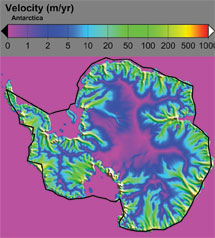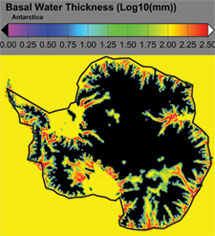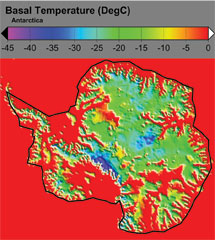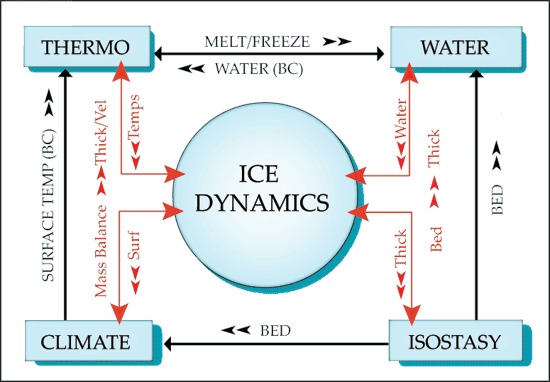Model Description
Glacier modelers attempt to combine both topographical and climate data to construct a computer-generated picture or dynamic model, that is able to change over time, just as the ice sheets have. Across the landscape, various features have been recognized as glacially created or modified. Few of these geological indicators give us any information about the thickness of the ice sheets; instead they only indicate where ice was present over the landscape at a given time. Dynamic models allow us to reconstruct the shape, as well as the outline, of past ice sheets.
Determining The Dynamic State of the Existing Ice Sheets
An important reason for modeling the current state of ice sheets is that the way in which ice sheets are changing can serve as a climatic indicator. During warm, dry periods we expect the ice sheet margins to retreat. During cool, moist periods we expect them to advance. Ice sheets are integrators of climate; they filter the natural climatic variation and extract out, or smooth, the general trend in the climate.
Interpreting Glacial Geology
Glacier modelers depend on glacial geologists to provide them with data constraints on the behavior of their models. At the same time, modelers can provide geologists with a filter for understanding their field data. If the geologic record is incomplete or fragmentary, modeling scenarios can often assist in filling in the blanks.
An Ice Sheet Laboratory
In trying to understand the behavior of ice sheets, one cannot design controlled experiments as one does in the laboratory. Numerical models provide the only arena for conducting experiments on ice sheets. What happens to the shape of an ice sheet as the amount of snowfall increases or decreases? How rapidly does it respond to a change in external conditions? Models can be used to answer these types of what if questions.
Antarctic reconstruction of present-day ice sheet showing velocities, basal water, and basal temperature. The bed at the melting point produces water which lubricates the ice streams.



The University of Maine Ice Sheet Model has expanded from the original mass and momentum
ICE DYNAMICS solver which forms its core, to include components for calculating:
- THERMODYNAMICS for internal ice temperatures.
- ISOSTASY for the response of the bed to changing ice load.
- BASAL WATER for the distribution and movement of water produced by basal melting, used to predict regions where sliding occurs.
- CLIMATE for the response of the net accumulation rates to changing climate and ice sheet configuration.
- ICE SHELF/CALVING for the grounding line response to the changing ice sheet.
- EMBEDDED model, for better resolution with reasonable run times.
All of these are important improvements that increase the accuracy of the physics, as well as the realism and utility of the model.

Selected References
Huybrechts, P. et al., 1996. The EISMINT benchmarks for testing ice-sheet models. Annals of Glaciology, 23:1-12.
Ackert, R.P. et al., 1999. Measurements of past ice sheet elevations in interior West Antarctica. Science, 286:276-280.
Payne, A.J. et al., 2000. Results from the eismint phase 2 simplified geometry experiments: the effects of thermomechanical coupling. J. Glac., 46(153):227-238.
Bliege Johnson, J. and J.L. Fastook, 2002. Northern hemisphere glaciation and its sensitivity to basal melt water. Quat. International, 95-96:65-74.
Kleman, J., J. Fastook, and A. Stroeven, 2002. Geologically and geomorphologically constrained numerical model of Laurentide Ice Sheet inception and build-up. Quat. International, 95-96:87-98.
Naslund, J.O., J.L. Fastook, and P. Holmlund, 2003. New ways of studying ice sheet flow directions and glacial erosion by ice sheet modeling - examples from fennoscandia. Quaternary Science Reviews, 22(2-4):89-102.

